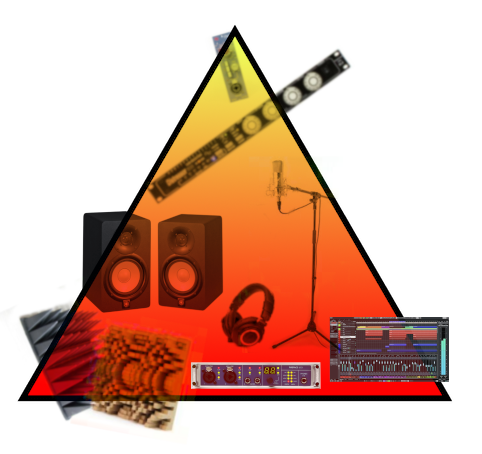Make small Moves towards your ideal Setup
Every home studio owner and recording enthusiast knows – there is an endless list of possibilities and you could never ever run out of things to buy. But if you are thinking about upgrading your studio equipment, think 3 steps ahead instead of one. What does your ideal setup look like? Are you mixing in the box on a simple but high-end setup? Is a console the center piece of your studio? Is your workflow leaning more towards analog or digital? Once you have figured out where you want to go, start ranking your personal priorities. Save up money over a longer period to invest into better gear the higher the priority on your list! Remember a strong Pyramid is built upon a strong foundation.

Room Acoustics
We like fantasizing about shiny pieces of gear more than fancy acoustic room treatments. However, it is a fact that if your recording and mixing space doesn’t meet a minimum requirement in terms of acoustic quality, even the best equipment will produce sub-par results. If you are a beginner and bought your own microphone, interface and speakers, you should look into acoustic panels next. Acoustic treatment can also be fun! Ever thought about building your own acoustic panels? Or maybe your own skyline diffuser to enhance the sound of your room. The reality is that if your room sounds bad your recordings and mixes will most likely sound bad as well. Improvements to your room acoustics will enhance the overall impression of your mixes, because of A cleaner takes and B a more accurate mixdown.
The Interface
The Audio Interface is arguably the most important piece of equipment you will ever buy for your recording setup. It will also be a long-term investment if you stretch your budget a little bit.
Real-Life example: Quiet a few years ago when my studio was much smaller, I purchased a RME Fireface USB Interface for around €800, similar to what it costs now. It was the most expensive piece of equipment in my studio at that time. Over the years I’ve accumulated a bunch of extra outboard equipment, also much more expensive, but I’ve not yet felt like my Interface is the bottleneck when it comes to sound. If back in the days I would have gone with a interface in the 400-500€ pricerange, instead of streching my budget and going with the RME, I would have definitely had to upgrade it by now. A classic example of “buy expensive once instead of cheap twice!”
Your Interface will provide you with routing possibilities, a converter, microphone or instrument pre-amps and a headphone output. In a very expensive setup one wouldn’t be surprised to see all of these components in seperate dedicated units, because those can offer the highest possible quality. If your total Budged is below that of a new car you’d be well-advised to look into a quality interface that can offer you all of these functions.
Let’s start off with the converter: Everything you listen to and record on your computer will run through either a Analog-to-Digital or Digital-to-Analog converter. The converter will transform electric signals coming from your preamp or line inputs into digital data, and the data coming from your computer back into a line-level electric signal. Understandably the sophistication of this process is essential for resolution and sound-quality. It is one of the main reasons why you should never use your computer’s onboard soundcard to record music. A bad converter will hurt your studio in two ways: it will diminish the sound quality of what you are recording, and also diminish the quality of whatever you are playing back through your speakers or headphones.
Built-In-Preamps. There are indeed pros and cons for built in preamps. If you are going for a specific sound, especially in the more colored range, the (enormous) interface market will not give you many options. While there are indeed already interfaces with built-in tube preamps available(no comment on how good or bad they are), most higher-end interfaces will ideally provide you with clean and transparent mic preamps that are versatile enough to be used with many sources. If your Interface Budget exceeds €1000, it could make sense to consider an external preamp. If your budged is well below €1000 it would be wise to invest in a good interface with decent preamps, that you can use until you can afford to upgrade to an ever better preamp while keep using the same interface. If you plan on buying a dedicated preamp from the start, you can aim for a converter-only interface, which could possibly give you higher quality converters at the same price point, since it doesn’t have the preamps on board.
Routing. A Interface with a flexible routing software will empower your workflow and become more necessary the more complex your setup becomes. Similar to a patchbay it may not make a big difference at first, but as you add pieces of gear to your setup you won’t be able to live without it.
Studio Monitors
Usually when someone gets their first pair of studio monitors, a revelation moment will take place. Even higher priced consumer speaker systems will in most cases give a representation of the music that is as realistic and neutral as many studio monitors do. But watch out – Studio Monitor quickly became a marketing term for any active speaker. Seek out speakers that have been proven to be good.
There’s a myth that studio monitors are supposed to sound boring and flat, because they need to give you a neutral frequency response. The truth is great monitors should also sound great when you play great music on them, and just like any speaker they have to fit your personal taste in sound.


